 |
 |
 |


| |
1900s
Wright Flyer
The Wright Flyer, which made the world's first sustained, controlled
heavier-than-air flight on December 17, 1903, at Kitty Hawk, ushered in the Age
of Flight with a host of innovations. Pioneered by Orville and Wilbur
Wright, these breakthroughs included wing warping, which allowed them to
control their machine in the roll axis, and the most efficient propeller the
world had ever seen, which they realized created lift just like a wing does.
They also introduced aspects of aeronautical engineering that are still in use
today, including flight testing and wind tunnels.
|


| |
1910s
Fokker E.III
Dutch aircraft designer Anthony Fokker gave the Germans a short-lived but significant lead in air fighting capability in World War I when he introduced a synchronized gear that timed the firing of machine-gun bullets so that they passed between the whirling blades of the propeller. This so-called interrupter enabled fighter pilots to aim the plane itself at an enemy rather than have to rely on a swivel-mounted gun. First used on Fokker's E Series of planes, including the main production model, the Eindecker E.III, Fokker's invention sparked a battle among nations for technological superiority in the air that continues to this day.
|
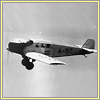

| |
1920s
Junkers F 13
The Junkers F 13 was arguably the first modern commercial aircraft. It pioneered the use of an all-metal structure—an aluminum alloy frame sheathed in corrugated sheet metal—and a dual-control mechanism, so the pilot and co-pilot could share the tasks of flying. It seated four passengers in an enclosed cabin with upholstered seats, heating, and lighting (Junkers dubbed it an "air limousine"). First flown in June 1919, the F 13 played a major role in the development of passenger, freight, and postal air traffic in the 1920s. More than 300 F 13s were built before the model was discontinued in 1932.
|
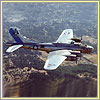

| |
1930s
Boeing B-17
After seeing the prototype of this new four-engine bomber in 1935, a journalist dubbed it the "Flying Fortress." The name stuck, and not just because it was catchy. The B-17E, one of several progressively more impressive variants, featured no fewer than 13 machine guns and could carry up to 17,600 pounds of bombs. All told, the B-17 dropped more bombs than any other American aircraft in World War II. And it was remarkably robust: many that suffered major damage to wings, fuselage, or tail brought their crews safely back to base. By the time the last Flying Fortress came off the production lines in April 1945, more than 12,300 of these planes had been built.
|
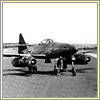

| |
1940s
Me 262
The Messerschmitt ME 262 was the first operational jet aircraft. With a top speed of 540 mph, it was about 100 mph faster than any propeller-driven fighter. By the time it went into operation in July 1944, the Allies all but ruled the air, and the plane never fully came into its own. But the Me 262 introduced elements in addition to turbojet power that later became standard in many jet aircraft, including swept-back wings, wing slots, and fully retractable, tricycle-style landing gear. And the plane flown by the fighter ace who scored more aerial victories than any other in the history of jet flight was an Me 262.
|
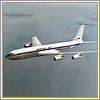

| |
1950s
Boeing 707
Along with the British-built de Havilland Comet, the Boeing 707 launched the age of mass air transportation by proving it could carry enough passengers fast enough to make long-distance routes profitable for an airline. America's first jet airliner, it entered service in October 1958, when Pan Am began international flights (domestic flights began soon after). The Boeing 707 was significantly larger and faster than the Comet, with a maximum range of 3,500 miles. This enabled it to fly from New York to San Francisco in five hours—three hours less than it took the piston-engine DC-7. All told, Boeing built 855 707s before retiring the model in 1972.
|
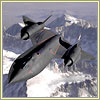

| |
1960s
Lockheed SR-71
In the mid-1950s, the U.S. military realized it needed a better platform to track Soviet military movements behind the Iron Curtain than the U-2 spy plane, which was becoming vulnerable to Soviet interceptors and missiles. This need gave rise to the SR-71 "Blackbird," one of the most innovative planes ever built. With a top speed of 2,200 mph, it remains the fastest aircraft propelled by air-breathing engines ever built. Design innovations abounded, including a titanium outer skin to protect the internal aluminum frame from the intense friction heat created by flying at more than three times the speed of sound; a complex engine intake and bypass system to prevent supersonic shock waves from causing flameouts in the engines; and a sleek, anti-radar body coated with a special black paint that tended to absorb rather than reflect radar waves. The last SR-71 flights took place in the late 1990s.
|


| |
1970s
Concorde
As early as 1956 Britain and France began research on developing a supersonic transport. The result was Concorde, a sharp-nosed white jet bristling with design advancements. It flew at heights reaching 11 miles and at about 1,350 mph, or more than twice the speed of any traditional subsonic aircraft. Its two most distinctive features to the layman were its delta wing, which provided greater lift during takeoff and landing and more stability and less drag during flight, and its hinged nose. Since the plane had a high angle of attack during takeoff and landing, the nose pivoted down five degrees for takeoff and 12.5 degrees for landing to enable the pilots to see the runway. Concorde was also the first commercial aircraft to use "fly-by-wire," or computer-based flight control. In the end, it was too costly to fly profitably, and it was retired in 2003.
|


| |
1980s
Lockheed F-117
The world's first operational stealth aircraft, the F-117 is loaded with innovations. Beyond its radar-absorbent coating and stealthy arrowhead design, the single-seat plane features advanced navigation, attack, and automated mission-planning systems. It has flat, matte-black surfaces, an internal weapons bay, above-fuselage engine exhausts, and a cockpit that is more or less flush with the rest of the plane—all of which help to reduce the F-117's radar and infrared signature as it flies in enemy territory. The plane first saw action in Panama in 1989 and has been an Air Force staple ever since. In Operation Desert Storm alone, the fighter flew more than 1,250 sorties and dropped more than 2,000 tons of bombs; not a single plane was lost.
|
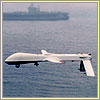

| |
1990s
General Atomics RQ-1 Predator
This unmanned aerial vehicle, or UAV, first demonstrated its value over Bosnia in 1995, and the U.S. Air Force has used it successfully in numerous conflicts ever since. During flight, a ground-based crew communicates with the UAV through direct links or, when the plane is beyond line of sight, through satellite data links. Equipment carried in the Predator's bottom turret can provide photographs, radar imagery, and even live video in all types of weather, day or night. Using satellites, ground crew can transmit these images to commanders anywhere in the world in real time. Able to fly in circumstances deemed too dangerous for manned planes, Predators have even successfully fired Hellfire air-to-ground missiles at targets on the surface.
|
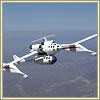

| |
2000s
SpaceShipOne
Arguably the most innovative aircraft of the 21st century, so far, is SpaceShipOne (shown here attached to its carrier plane, White Knight). Designed by perhaps the most creative aircraft designer now living, Burt Rutan, this spacecraft won the $10 million Ansari X Prize. The prize, set up to encourage the development of space tourism, went to the team that safely sent a piloted aircraft to a height of 100 kilometers (62 miles), the unofficial edge of space, twice in a single week. On October 4, 2004, SpaceShipOne accomplished that feat. The craft has many unique elements, including a fuel system that supplies explosive rocket power by combining nitrous oxide and solid rubber, and wings that fold up to provide high drag for reentry. In a nod to modernity, Rutan's team, unlike the Wright Brothers, uses no wind-tunnel testing; they derived all design refinements and predictions of performance from computer modeling.
|

| 
|

